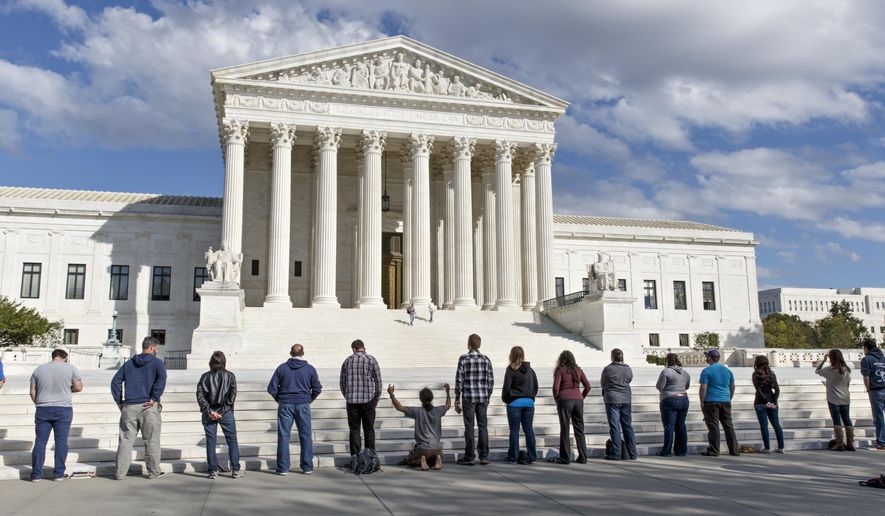The Supreme Court of the United States is an Ursa Minor not an Ursa Major of constitutional law.
Its jurisprudence more follows than opposes the election returns. As Supreme Court Justice Benjamin Cardozo lectured, “The greatest tides and currents which engulf the rest of men, do not turn aside in their course, and pass the judges idly by.”
The court is the least dangerous branch less because it lacks both the sword and the purse, than because it sticks close to prevailing orthodoxies.
The first Monday in October marks the commencement of the 10th term of the Supreme Court under the leadership of Chief Justice John Roberts. None of the cases on the current docket is a trail blazer. The most prominent highlight the court’s diminutive influence in national affairs.
It may decide whether there is a federal constitutional right to same sex marriage. But whatever it decides, same sex marriage throughout the nation is ineluctable in the near future. At present, 19 states and the District of Columbia recognize same sex marriage, and the political winds are all in the same direction. The elderly are a major obstacle to recognition, but their replacements by more liberally minded youths are rapidly changing the political equation. A Gallup Poll in May 2014 found that 55 percent of Americans support same sex marriage.
The court may also address whether the Affordable Care Act (aka Obamacare) authorizes federal subsidization of insurance premiums when policies are purchased over federal- rather than state-operated insurance exchanges. But Obamacare or its equivalent will live on irrespective of the decision. If the court were to nix subsidies for federally operated exchanges, the 17 states that currently operate eligible state exchanges would be quickly joined by others to benefit their citizens at federal expense.
In Zivotofsky v. Kerry, the court will decide whether the President’s constitutional powers over foreign affairs prohibits Congress from requiring the State Department to treat Jerusalem as part of Israel in issuing American passports.
The case is much ado about nothing.
The paramount foreign policy disputes between Congress and the president are over unilateral presidential wars, presidential authority to kill American citizens without due process, the president’s invocation of state secrets to thwart congressional or judicial oversight, and warrantless surveillance of the nation’s entire population. In each and every case, Congress has pusillanimously conceded victory to the president, which precludes adjudication of the issues by the Supreme Court except at the edges.
The Supreme Court has never consistently bucked public opinion. When white supremacy was the cultural norm, the court embraced the odious “separate-but-equal” doctrine for 60 years. It abandoned white supremacy in Brown v. Board of Education only after President Harry Truman had desegregated the armed forces, and both major political parties had endorsed civil rights in their party platforms. Even after the Brown decree, the court dawdled over enforcing school desegregation for another 15 years. That intermezzo witnessed Rosa Parks and the Montgomery bus boycott, the Freedom Riders, the Civil Rights Act of 1964 and the Voting Rights Act of 1965, and Martin Luther King Jr.’s “I Have a Dream” speech. The court was the caboose, not the locomotive, in the civil rights revolution.
The Supreme Court voided the nation’s capital punishment laws in Furman v. Georgia on procedural grounds. Within a few years, a majority of states re-enacted death penalty statutes satisfactory to the court’s procedural imperatives.
In its controversial Roe v. Wade ruling recognizing a constitutional right to an abortion, the court acted with a tailwind of 20 recent state enactments relaxing abortion restrictions. Indeed, then-California Gov. Ronald Reagan signed the 1967 Therapeutic Abortion Act, a virtually precursor of Roe.
The court’s decree, however, was somewhat ahead of its time. It soon adapted the Roe precedent to the prevailing mixed public sentiments about abortion with an “undue burden” test in Planned Parenthood v. Casey and an endorsement of prohibitions on partial-birth abortions in Gonzales v. Carhart.
In theory, the Supreme Court independently interprets the Constitution.
In fact, the court is a slave to ascendant orthodoxies in discharging the interpretive task.
For more information about Bruce Fein, please visit brucefeinlaw.




Please read our comment policy before commenting.